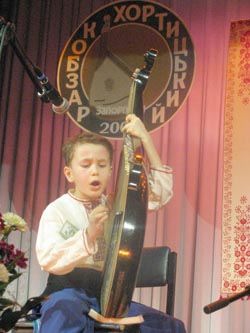Have you heard the bandura?
Zaporizhia hosts the first All-Ukrainian Competition “Khortytsia Kobzar”
Zaporizhia — The kobzars’ art is not as popular as show business nowadays. It aims at spiritual development of a personality based on one’s ethnic identity. However, Ukrainians do not value their native art too much, which is testified by the half-empty Glinka Concert Hall in Zaporizhia during the “Khortytsia Kobzar” festival-cum-competition. The organizers decided to dedicate the festival to Taras Shevchenko’s 195th birthday anniversary, so performing musical compositions based on his lyrics was a must.
The festival featured 42 participants from 13 oblasts of Ukraine: Vinnytsia, Chernihiv, Rivne, Kharkiv, Cherkasy oblasts, and so on. Due to the current financial situation there weren’t many contestants. The performers competed within two age groups (6–12 and 12–16) and two nominations: instrumental bandurysts and singing bandurysts. For the majority of the young performers, as, for example, for eight-year old Arsenii Titenko from Chernihiv, who became the First Prize Laureate and won in the “Discovery of the Year” nomination, this festival was the first one. According to the boy, he came here to win, although he was aware that there were not enough prizes for everybody. As it is known that the art of playing the bandura is better developed in western Ukraine, the question was if there is any difference in performing skills between musicians from the western and eastern regions.
“The level of their performing skills is nearly identical, and it is increasing,” says Volodymyr Horbatiuk, Honored Art Worker, a kobzar, and a member of the jury. “This was proved by the young musicians’ performance. In addition to songs with Taras Shevchenko’s lyrics, the bandurysts easily played classical music by Bach and Handel, followed by bright modern boogie-woogie and Tsyganochka. But Ukrainian music sounded most attractive of all. The bandura seems to have been created just for that: like dew for grass, like husband for wife, etc.
“This instrument may contain the clue to understanding the Ukrainian soul and the life of our people. Are contemporary Ukrainians aware of this? Maybe the kobzars’ art will first decay and then people will rush to revive it? Only two factories used to manufacture the banduras in Ukraine: one in Chernihiv and the other one in Lviv. But nowadays only the one in Lviv is operating.”
“If it were possible to restore a single bard to life in Ireland, they (the Irish) would pay millions of dollars for that. And we have our kobzars; they are the bearers of our epic culture and our national consciousness. We ought to value them,” said Volodymyr Yesypok, People’s Artist of Ukraine, head of the Ukrainian National Kobzar Union, and the head of the festival’s jury.
Watching the young bandurysts’ excitement, one wishes to hope that they will continue to spread this unique Ukrainian art. According to Yesypok, the world tends to return to the folk roots: folk musical instruments are becoming more and more popular. That is why the bandura has some bright prospects.
The bandura is often mistaken for the kobza, although they are very different instruments. The definitions of a banduryst and a kobzar are also quite subjective. The listeners have to determine for themselves whether they are listening to a banduryst or a kobzar.
“Being a kobzar does not necessarily mean playing the kobza. As a rule, kobzars played the banduras,” notes Horbatiuk, “Only a few could play the kobza because it is a lute-like instrument, a semi-bandura. Kobzars educate people patriotically and ethnically.”
Towards the end of the festival the names of the prize winners and laureates were announced. The First Prize went to Yurii Klymets from Rivne, Arsenii Titenko and Kateryna Simonova from Chernihiv, and Maria Kochura from Dnipropetrovsk.






